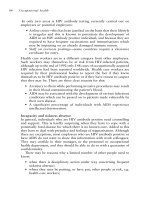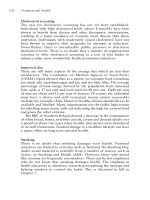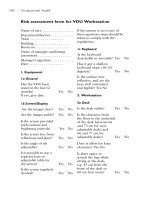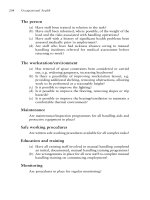Developing affordable housing a practical guide for nonprofit organizations
Bạn đang xem bản rút gọn của tài liệu. Xem và tải ngay bản đầy đủ của tài liệu tại đây (24.7 MB, 842 trang )
ffirs.fm Page iii Wednesday, March 15, 2006 4:54 PM
Developing Affordable Housing
A Practical Guide
for Nonprofit Organizations
Third Edition
Bennett L. Hecht, JD, CPA
John Wiley & Sons, Inc.
ffirs.fm Page ii Wednesday, March 15, 2006 4:54 PM
ffirs.fm Page i Wednesday, March 15, 2006 4:54 PM
Developing Affordable Housing
ffirs.fm Page ii Wednesday, March 15, 2006 4:54 PM
ffirs.fm Page iii Wednesday, March 15, 2006 4:54 PM
Developing Affordable Housing
A Practical Guide
for Nonprofit Organizations
Third Edition
Bennett L. Hecht, JD, CPA
John Wiley & Sons, Inc.
ffirs.fm Page iv Wednesday, March 15, 2006 4:54 PM
This book is printed on acid-free paper.
Copyright © 2006 by John Wiley & Sons. All rights reserved.
Published by John Wiley & Sons, Inc., Hoboken, New Jersey.
Published simultaneously in Canada.
No part of this publication may be reproduced, stored in a retrieval system, or transmitted in any form
or by any means, electronic, mechanical, photocopying, recording, scanning, or otherwise, except as
permitted under Section 107 or 108 of the 1976 United States Copyright Act, without either the prior
written permission of the Publisher, or authorization through payment of the appropriate per-copy
fee to the Copyright Clearance Center, Inc., 222 Rosewood Drive, Danvers, MA 01923, 978-750-8400,
fax 978-646-8600, or on the web at www.copyright.com. Requests to the Publisher for permission
should be addressed to the Permissions Department, John Wiley & Sons, Inc., 111 River Street,
Hoboken, NJ 07030, 201-748-6011, fax 201-748-6008, or online at />permissions.
Limit of Liability/Disclaimer of Warranty: While the publisher and author have used their best efforts
in preparing this book, they make no representations or warranties with respect to the accuracy or
completeness of the contents of this book and specifically disclaim any implied warranties of
merchantability or fitness for a particular purpose. No warranty may be created or extended by sales
representatives or written sales materials. The advice and strategies contained herein may not be
suitable for your situation. You should consult with a professional where appropriate. Neither the
publisher nor author shall be liable for any loss of profit or any other commercial damages, including
but not limited to special, incidental, consequential, or other damages.
For general information on our other products and services, or technical support, please contact our
Customer Care Department within the United States at 800-762-2974, outside the United States at
317-572-3993 or fax 317-572-4002.
Wiley also publishes its books in a variety of electronic formats. Some content that appears in print
may not be available in electronic books.
For more information about Wiley products, visit our Web site at .
Library of Congress Cataloging-in-Publication Data:
Hecht, Bennett L., 1959Developing affordable housing : a practical guide for nonprofit organizations / Bennett L.
Hecht.—3rd ed.
p. cm.
Includes bibliographical references and index.
ISBN-13: *978-0-471-74346-0 (cloth)
ISBN-10: 0-471-74346-1 (cloth)
1. Housing development—United States—Handbooks, manuals, etc. 2. Housing
rehabilitation—United States—Handbooks, manuals, etc. 3. Housing management—United
States—Handbooks, manuals, etc. 4. Nonprofit organizations—United States—Handbooks,
manuals, etc. I. Title.
HD259.H43 2006
333.73'150973—dc22
2005058121
Printed in the United States of America
10
9
8
7
6
5
4
3
2
1
ffirs.fm Page v Wednesday, March 15, 2006 4:54 PM
To Lynn, Eliza, and Sam
ffirs.fm Page vi Wednesday, March 15, 2006 4:54 PM
ftoc.fm Page xvii Wednesday, March 15, 2006 4:26 PM
Contents
PART ONE
GETTING STARTED
1
Chapter 1 Developing Affordable Housing in the Twenty-First Century 3
1.1
1.2
1.3
1.4
1.5
Introduction
The Current State of America’s Affordable Rental Housing
The State of America’s Working Poor Seeking Affordable Housing
Current Trends in Affordable Housing
Unique Opportunities for Nonprofit Organizations: Rental and
Homeownership
3
4
4
6
10
Chapter 2 The Real Estate Development Process for Nonprofit
Organizations: An Overview
2.1
2.2
2.3
Nonprofit Organizations and the Real Estate Development Process
An Overview of the Real Estate Development Process
Addressing the Specific Needs of a Community
and a Specific Project Site
Chapter 3 Establishing the Development Team
3.1
3.2
3.3
3.4
3.5
3.6
3.7
3.8
3.9
3.10
3.11
3.12
In General
The Sponsor
The Financial Development Specialist
Attorneys
Accountant/Bookkeeper
Architect
Property Management Company
General Contractor
Construction Manager
Community Organizer
Appraiser
Conflicts, Multiple Roles, and Oversight
13
13
14
17
19
19
20
20
21
25
26
28
29
29
29
31
32
ftoc.fm Page xviii Wednesday, March 15, 2006 4:26 PM
CONTENTS
PART TWO PROJECTING COSTS, INCOME, AND EXPENSES
33
Chapter 4 Project Feasibility and Total Development Costs
35
4.1
Project Feasibility Defined
4.2
Determining Preliminary Project Feasibility
4.3
Estimating Total Development Costs
Appendix 4A Sample Letter of Value
35
36
36
60
Appendix 4B Summary of Key Federal Regulations Governing
Underground Storage Tanks
63
Appendix 4C Summary of Relevant Laws and Regulations
Governing Lead-Based Paint
66
Chapter 5 Determining Projected Income and Expenses
5.1
5.2
5.3
5.4
Introduction
Projecting Income—Generally
Identifying Targeted Income Levels
Determining Affordability as a Percentage
of Income and Market Rents
5.5
Income from Nonresidential Use
5.6
Projecting Expenses—Generally
5.7
Evaluating Past Operating Expenses
5.8
Projecting Expenses Where No Operating History Exists
5.9
Allowances and Reserves
5.10 The Role of Lenders
Appendix 5A Controllability of Expenses
PART THREE
RAISING CAPITAL
6.1
Introduction
6.2
Sources of Capital—Generally
6.3
Loans
6.4
Grants
6.5
Equity and Sales Proceeds
Appendix 6A Example of an Amortizing Loan
Appendix 6B Example of a Nonamortizing Loan
Chapter 7 Sources of Capital: Loans
xviii
71
74
74
75
77
80
83
84
87
87
88
88
102
103
105
106
107
Who are Possible Lenders?
Sources of Loan Funds from Public Lenders—Generally
Sources of Loans from State and Local Governments
Ⅲ
69
70
70
85
Chapter 6 Raising Capital to Meet Total Development Costs
7.1
7.2
7.3
69
Ⅲ
107
107
108
ftoc.fm Page xix Wednesday, March 15, 2006 4:26 PM
CONTENTS
7.4
Sources of Loans from the Federal Government
7.5
Sources of Loan Funds from Private For-Profit Entities
7.6
Sources of Loan Funds from Private Nonprofit Entities
Appendix 7A 501(c)(3) Bond Terminology
Appendix 7B List of Local CDFI Organizations Financing Housing
Chapter 8 Sources of Capital: Grants
8.1
8.2
8.3
8.4
225
Grants from the Federal Government
Grants from State and Local Governments
Grants from Private Nonprofit Foundations
Grants from For-Profit Corporations
Chapter 9 Sources of Capital: Equity
Appendix 9B Partial Listing of Low-Income Housing Tax Credit
Tax Syndicators
Chapter 10 Sources of Capital: Public Housing Funds
10.2
10.3
10.4
10.5
10.6
225
236
236
244
245
9.1
Creation of an Equity Fund for Housing Development
9.2
Use of the Low-Income Housing Tax Credit
9.3
Other Equity Sources
Appendix 9A Tax Credit Information Resources
List of State and Regional Tax Credit Equity Funds
10.1
128
138
149
218
219
How Public Housing Resources Contribute to
Affordable Housing
Mixing Public Housing Capital with other Capital: Mixed Finance
Uses of Public Housing Funds in Mixed-Finance Transactions
Considerations in Mixing Public Housing Development Funds
with other Sources of Affordable Housing Funds
Elements of Public Housing Development Transactions
Conclusion
245
246
259
266
275
279
280
286
288
293
298
313
PART FOUR ENHANCING FEASIBILITY AND PACKAGING
THE PROJECT
315
Chapter 11 Enhancing the Feasibility of an Affordable
Housing Project
11.1
11.2
11.3
11.4
11.5
317
Increasing Access to Capital—Credit Enhancement
Increasing Access to Capital—Loan Sales on Secondary Market
Reducing Total Development Costs
Increasing Income
Reducing Operating Expenses
Ⅲ
xix
Ⅲ
318
325
344
349
360
ftoc.fm Page xx Wednesday, March 15, 2006 4:26 PM
CONTENTS
Chapter 12 Developing the Project Feasibility Report:
Six Case Studies
363
12.1 Introduction
12.2 The Feasibility Report and Financial Pro Formas
12.3 The Development of Affordable Housing: Six Case Studies
12.4 Conclusion
Appendix 12A The Whitelaw Reference Information
363
364
368
384
385
Appendix 12B
397
Friendship Court Reference Information
Appendix 12C Garden Terrace Reference Information
399
Appendix 12D The View Reference Information
406
Appendix 12E
Kentucky Mountain Housing Reference Information
415
Appendix 12F
Lease-Purchase Reference Information
420
PART FIVE
PURCHASING AND DEVELOPING THE PROPERTY
427
Chapter 13 Securing Site Control over the Property: Signing
the Option or Purchase Agreement
429
13.1 Introduction
13.2 Site Control Must Be Secured in Writing
13.3 The Use of Purchase Contracts
13.4 The Use of Options
Appendix 13A Documents Pertaining to Purchase Contracts
429
429
430
444
448
Appendix 13B
457
Documents Pertaining to Option Agreements
Chapter 14 Prepurchase Considerations
14.1
14.2
14.3
14.4
14.5
Introduction
Applying for Financing and Operating Subsidies
Determining the Ownership Entity—Generally
Determining the Ownership Entity—Corporations
Determining the Ownership
Entity—Partnerships
14.6 Determining the Ownership Entity—Factors
14.7 Establishing the Ownership Entity: Divided Ownership
and Leasehold Interests
14.8 Interviewing and Selecting the Management Company
14.9 Developing Plans for Renting or Selling Units
Appendix 14A Monthly Management Reports
Chapter 15 Partnerships and Joint Ventures
15.1
15.2
15.3
Issues Concerning Organization’s Tax-Exempt Status
Options for Structuring the Relationship
Partnerships and the Use of the Low Income Housing Tax Credit
Ⅲ
xx
Ⅲ
465
465
465
466
466
468
470
476
477
478
483
503
503
510
518
ftoc.fm Page xxi Wednesday, March 15, 2006 4:26 PM
CONTENTS
Appendix 15A
Joint Venture Checklist
523
In General
Board Involvement
Day-to-Day Management
523
524
525
Chapter 16 Purchasing the Property: Settling on Acquisition
527
16.1 The Settlement Process—Generally
16.2 The Role of the Settlement Agent
16.3 Title Insurance
16.4 Selecting the Settlement Agent
16.5 Preparing for Settlement
16.6 Settlement
16.7 Postsettlement
16.8 Lender Requirements
16.9 Governmental Regulations
Appendix 16A Settlement Checklist and Sample Documents
527
527
528
529
531
533
537
538
539
541
Chapter 17 Constructing or Rehabilitating the Property:
Settling on the Construction Loan and Surviving
the Construction Process
17.1
17.2
17.3
Introduction
Settling on the Construction Loan
The Construction Process—The Participants and Their
Responsibilities
17.4 Technology in 21st Century Affordable Housing Construction
and Rehabilitation
17.5 Negotiating the Construction Contract and Bidding
17.6 Elements of the Construction Contract
17.7 Rehabilitating an Occupied Property
17.8 Completion of Construction
Appendix 17A Construction Process Checklist and Sample
Contractor Agreements
Chapter 18 Selective Rehabilitation
18.1
18.2
18.3
18.4
18.5
18.6
xxi
553
554
555
575
577
593
602
603
605
665
Overview
Introduction to Selective Rehabilitation
Managing Selective Rehabilitation: Formal Versus Informal
Approaches
Implementing a Formal Approach to Selective Rehabilitation:
The Rehabilitation Specialist
Choosing A Property for Selective Rehabilitation:
Building Inspection Techniques of Rehab Specialists
Conceptualizing the Project: Rehabilitation Standards
Ⅲ
553
Ⅲ
666
666
673
675
676
678
ftoc.fm Page xxii Wednesday, March 15, 2006 4:26 PM
CONTENTS
18.7
18.8
18.9
18.10
18.11
18.12
Designing the Project: Work Write-Ups and Cost Estimates
Computerized Specification-Writing and Estimating Systems
Defining Methods and Materials: Performance Specifications
Selective Rehabilitation and Construction Management
Selective Rehabilitation and the Contractor Pool
The Role of Government Agency/Public-Purpose
Organizations in Selective Rehabilitation
18.13 Avoiding Gut Rehabilitation: Tips of the Trade
18.14 Improving Energy Efficiency in Selective Rehabilitation
18.15 Dealing With Lead-Based Paint Hazards in Selective
Rehabilitation
18.16 Dealing With Other Recurring Health and Safety Issues in
Selective Rehabilitation
18.17 Applying Construction Codes and Existing Housing Codes
to Selective Rehabilitation
18.18 Standards Issues with Funders and Selective Rehabilitation
18.19 Information Sources and Tools for Selective Rehabilitation
Appendix 18A Sample Documents Regarding Rehabilitation
PART SIX
COMPLETING AND MANAGING THE PROPERTY
679
681
681
682
683
684
685
686
687
689
691
692
693
695
711
Chapter 19 The Project Completion Phase: Completing the
Development and Maintaining an Ownership
or Rental Community
19.1
19.2
19.3
19.4
Introduction
Settling on the Permanent Loan
Maintaining a Rental Property
Developing Additional Resident Services
As Part of a Comprehensive Property Management Plan
19.5 Key Points on Setting Performance Standards for
Comprehensive Property Management
19.6 Key Points on Deciding Whether to Contract for Management
or Manage Directly
19.7 Key Points on Selecting a Good Management Company
19.8 Key Points on Evaluating Property Management Performance
19.9 Financial Management of Rental
and Multifamily Homeownership
19.10 Converting the Property to Homeownership for Residents
19.11 Managing and Budgeting for Rental or Multifamily Ownership
Appendix 19A Sample Documents and Disclosure Statements
Index
713
713
714
717
733
734
734
735
740
745
754
757
763
805
Ⅲ
xxii
Ⅲ
fabout.fm Page vii Saturday, March 11, 2006 3:37 PM
About the Author
Bennett Hecht is an experienced nonprofit executive, author and social entrepreneur. He founded One Economy Corporation in 2000 to bring the power of the
Internet and the economic mainstream to low-income families living in affordable housing across the country. In five years, One Economy has earned the support of America’s leading foundations and corporations, brought high speed
Internet to $2 billion of affordable housing and helped more than five million
low-income people to help themselves at www.theBeehive.org. Immediately
before One Economy, Mr. Hecht was senior vice president at the Enterprise
Foundation. In that capacity, he led the organization’s efforts beyond housing—
building well-respected programs in childcare, workforce development and economic development. Under his leadership, the number of community-based
organizations working with the foundation doubled from 750 to more than 1,500
in 48 states; capitalization of the organization’s revolving loan fund grew from
$30 million to $200 million; and regional networks of nonprofit organizations
linked by technology were born in New England and the Northwest.
Mr. Hecht received his JD from Georgetown University Law Center and his
CPA from the State of Maryland. For 10 years he taught at Georgetown University Law Center, and built the premier housing and community development
clinical program in the country. In 1992, with Congressional support, Mr. Hecht
founded the National Center for Tenant Ownership at Georgetown, a program
facilitating affordable housing development by nonprofits and tenant groups
nationwide.
Prior to his work at Georgetown, Mr. Hecht worked for the public accounting firm of Coopers & Lybrand in Washington and served as counsel to the nonprofit National Rural Development and Finance Corporation. He has been an
adjunct professor of law at Georgetown University Law Center for 17 years,
teaching accounting concepts for lawyers. In 1997, he was awarded Georgetown’s prestigious Charles Fahy Distinguished Adjunct Professor Award. Over
the years, Mr. Hecht has served on the boards of nonprofit housing organizations in Portland, Oregon; Cleveland, Ohio; and New York City and on the
national boards of numerous organizations. He currently sits on the Georgetown
Day School and One Economy Board of Directors.
Ⅲ
vii
Ⅲ
fabout.fm Page viii Saturday, March 11, 2006 3:37 PM
ABOUT THE AUTHOR
Mr. Hecht has written two other books in addition to Developing Affordable
Housing: A Practical Guide for Nonprofit Organizations: ManagingNonprofits.org
(2001) with Rey Ramsey and Managing Affordable Housing: A Practical Guide for
Building Stable Communities (1996), with James Stockard and the Local Initiatives
Support Corporation, both published by John Wiley & Sons.
Ⅲ
viii
Ⅲ
fforw.fm Page ix Saturday, March 11, 2006 3:38 PM
Foreword
Housing matters—especially decent, stable, affordable housing. While education, health care, and workforce development often receive more attention, there
is mounting evidence that housing is a critical factor in opening opportunities to
individuals and improving communities. Recent studies confirm what we know
intuitively—that decent, stable housing improves the ability of individuals to
get and keep jobs, increases psychological well-being, and leads to better social
behavior and school achievement among children. Other studies link the availability of affordable housing to the economic vitality of cities and regions.
An adequate supply of such housing depends on a broad commitment to our
communities and their residents. Nonprofit housing developers work closely
with architects, bankers, construction contractors, property managers, public
officials and others. Together, they are making a critical difference. For nearly
three decades, nonprofit housing developers have demonstrated how essential
they are to the revitalization of communities. They increasingly understand the
relationship between the bricks and mortar they provide and the critical social
and economic supports that residents of their properties need to flourish.
In the early years of the twenty-first century, challenges abound. Federal
funding is likely to diminish. The regulatory environment that has helped bring
conventional capital to communities needing a revitalized stock of affordable
housing is weakening. It is difficult for nonprofit developers to purchase, recapitalize, and improve the thousands of affordable housing units that were built in
the 1970s and 1980s and whose federal subsidies are coming to an end. However,
these are all challenges that a greatly strengthened field of nonprofit housing
developers and their many allies are prepared to meet.
For over twenty-five years, the MacArthur Foundation has invested in housing. Today, our interest is deeper than ever. Since 2000 alone, more than $100
million in grants and loans have been committed to the development and preservation of affordable housing. These resources have helped nonprofit developers, and the specialized financing intermediaries that support them, ensure that
decent, affordable housing is available in both urban and rural communities.
Ⅲ
ix
Ⅲ
fforw.fm Page x Saturday, March 11, 2006 3:38 PM
FOREWORD
To be even more effective, these organizations need the kind of clear, practical guidance that can be found in Ben Hecht’s influential book. It has stood the
test of time, as the state of the field has changed, as development has become
more complex, and as the need for affordable housing has grown. I recommend
it to everyone who cares about American communities and understands the crucial role of affordable housing in their success.
Jonathan F. Fanton
President
John D. and Catherine T. MacArthur Foundation
Ⅲ
x
Ⅲ
fpref.fm Page xi Monday, March 13, 2006 12:09 PM
Preface
This is my third edition of Developing Affordable Housing. Much has changed in
the housing industry since I wrote the first edition more than ten years ago. The
federal government’s commitment has declined precipitously while the level of
state investment has grown. The idea of demolishing the most problematic public
housing developments and putting new, mixed income communities back in
their place has not only become a reality, but the norm. The federal low income
housing tax credit has become a permanent part of the rental housing landscape
and expanded dramatically into the suburbs. Preserving the existing stock of
affordable housing, not just building new units, has been embraced by an
increasing number of communities as leaders realize that lost units will never be
recaptured. Homeownership rates, especially for people of color and immigrants,
have hit historic high levels.
The face of America and those who live in its affordable rental housing has
changed as well. Immigrants accounted for more than a third of all U.S. household growth in the 1990s. In fact, the number of renter households in America
would have fallen during that period was it not for immigrant and minority
households. These changes have been accelerated further by historically low
mortgage interest rates that helped move millions of renters into homeownership.
Two other things also have grown over these ten plus years: the demand for
affordable housing and the capacity of nonprofit organizations to develop and
manage these units, when sufficient resources are made available to them.
Americans do not have income sufficient to afford decent, safe and affordable
housing. As recently as 2001, 95 million Americans had excess housing costs
burdens (pay more than 30% of their income for housing) or lived in crowded or
inadequate conditions. In 2004, the number of people earning $32–50,000 who
spent more than 30% of income on housing jumped to 4.5 million.
Nonprofit organizations, large and small, public and private, are the only
entities ready, willing and able to meet this demand. A 2005 study by the Joint
Center for Housing Studies at Harvard found that for-profit developers are
building for the high end of the market in increasing numbers. Of all the rental
housing units built since 2000, 43% cost more than $800 per month compared to
25% of all units built prior to that date. Only 10% of the units built since 2000
rented for less than $400 a month. Relatedly, a 2000 study by the Urban Institute
found that many nonprofit developers substantially increased their capacity to
produce affordable housing from 1990 to 2000. Many parts of the industry have
become much more sophisticated — using multiple sources of financing, highly
Ⅲ
xi
Ⅲ
fpref.fm Page xii Monday, March 13, 2006 12:09 PM
PREFACE
leveraging developer fees and shopping various funders for the most attractive
terms. Housing for the hardest to serve, such as the homeless, mentally ill and
addicted, can be found not just in dense urban areas, but in suburban and rural
communities.
My goal has been for Developing Affordable Housing to meet the user wherever they are—to provide a living resource for the citizens, policymakers, nonprofit executives and professionals who want to make affordable housing a
reality in their community. For the newcomer to the sector, this book provides a
step-by-step analysis of the nonprofit real estate development process, from feasibility to long-term management including checklists and sample forms and
reports, where necessary.
For the more experienced, the book allows you to expand your possibilities
by helping you identify relevant federal, state and local programs. The book provides a description of the existing federal loan, grant, mortgage insurance, rent
and operating subsidy programs (e.g., HOME, CDBG, HOPE VI, McKinney
Grants) and of common state and local government mechanisms used to finance
affordable housing.
Users over the years have found the detailed case studies that I provide, with
accompanying financial pro formas, to be one of the book’s most valuable features. This edition highlights six very different affordable housing organizations
and developments. Each development serves a unique population (e.g. homeless, seniors or families), utilizes a multiplicity of funding sources (e.g., low
income housing tax credits, tax-exempt bonds, private and public grants) and
now manages unique types of housing (e.g., single room occupancy, homeownership or rental). What these six organizations have been able to do and the way
they accomplished these developments is an inspiration to me and I hope to you.
Many communities have skilled and committed professionals such as lawyers, accountants, bankers, architects, and financial development specialists
who have never worked on affordable housing development projects but would
like to do so or to help existing nonprofit organizations to do so. This book provides these professionals with the kind of orientation and guidance that they
would need to enable them to play an active and valuable role as a development
team member in local affordable housing development projects.
Finally, many state and local governments have not developed the programs
or earmarked the resources necessary to facilitate the wholesale creation of affordable homeownership and rental housing opportunities by nonprofits in their
jurisdictions. This book provides a laundry list of ways that government can promote affordable housing, from providing tax relief to nonprofits purchasing or
transferring property and establishing flexible “soft second” mortgage programs
with CDBG funds, to providing technical assistance and HOME funds.
Chapters 1 to 5 provide guidance in putting together the right development
team and in helping the team through the steps necessary to determine if an
affordable housing project will be financially feasible. Chapters 6 to 12 highlight
the various sources of capital available for affordable housing development (loans,
grants, and equity), ways to reduce the costs of developing this housing, and
methods for presenting the financially feasible project to funding sources, profit
and nonprofit, public and private. Chapters 13 to 18 discuss the steps necessary to
Ⅲ
xii
Ⅲ
fpref.fm Page xiii Monday, March 13, 2006 12:09 PM
PREFACE
contract for, purchase, and rehabilitate or construct an affordable housing project.
Finally, Chapter 19 takes the nonprofit housing developer through the steps
needed to complete the project, sell out the units (if home-ownership developed),
and manage and maintain the property including the ongoing financial management of a multifamily property, whether ownership or rental.
This third edition has been updated to reflect the latest information and
issues facing the affordable housing industry. Major revisions have been made to
my earlier treatment of public housing finance and “mixed finance” opportunities (Chapter 10), joint ventures of nonprofit and for profit entities (Chapter 15),
and the case studies noted above (Chapter 2).
Decent and affordable housing often is the foundation whereby entire neighborhoods or individual families achieve a sense of stability. The information provided in this book should help nonprofit organizations, governments, technical
assistance providers, private and public lenders and foundations to work
together to bring this stability to people and communities throughout the United
States.
BENNETT L. HECHT
Washington, DC
February 2006
Ⅲ
xiii Ⅲ
fpref.fm Page xiv Monday, March 13, 2006 12:09 PM
fpref.fm Page xv Monday, March 13, 2006 12:09 PM
Acknowledgments
This third edition could not have been possible without the work and support of
a lot of people. My law clerks—Aimee Ferrer, Matthew Peed, Donald Saelinger,
Helki Spidle, and Jennifer Walrath—were invaluable in helping me to collect,
update, and summarize changes to housing loan, grant, and equity programs
throughout the country. I want to thank the law firm of Reno & Cavanaugh,
Washington, DC—especially, Julie McGovern, Jaime Alison Lee, Megan
Glasheen, and Lee Reno—for updating their excellent and important chapter,
Chapter 10, on public housing. Thanks go to Michael Sanders for permission to
excerpt his fine book on joint ventures between nonprofit and for-profit organizations found throughout the book, including Chapter 15. I want to thank Rick
Eisen, Eisen & Rome, Washington, DC; Barry Mullen, Chicago, IL; and Peter
Werwath, Vice President with the Enterprise Foundation, for their contributions
to Chapters 14, 16, 17, and 18, respectively. I am indebted to the nonprofit groups
featured in Chapter 12 for their leadership in the field, cooperation, time, and
efforts. I want to thank Susan McDermott, my editor at John Wiley & Sons, for
her support of this edition and her navigation of it through the production process. Finally, I want to acknowledge my wife, Lynn Leibovitz, my daughter,
Eliza, and my son, Sam, for all the support, love and joy that they bring me
everyday.
Ⅲ
xv Ⅲ
fpref.fm Page xvi Monday, March 13, 2006 12:09 PM
p01.fm Page 1 Saturday, February 18, 2006 9:33 AM
P A R T
O N E
2
Getting Started









